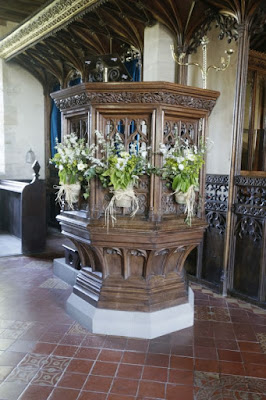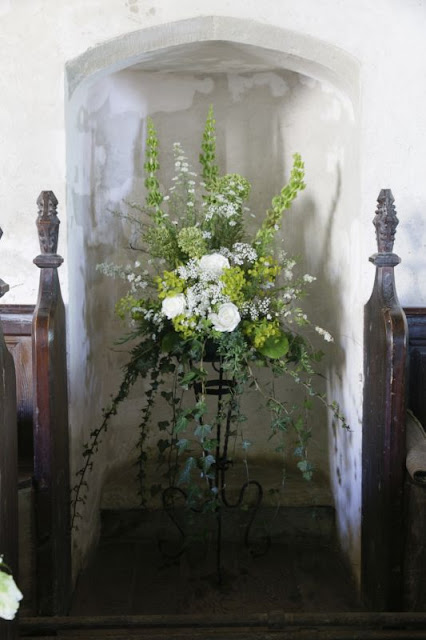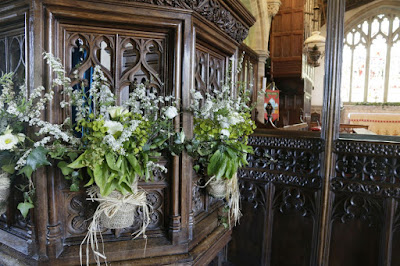Now I have visited this church before many years ago but as I am writhing this blog I thought it was worthy of a revisit. On my first visit I thought the church old but missed the significance of it all on my second visit my eyes were opened to the to it all and I was bowled over by what I missed the first time. So some history on the church, for a change I could find nothing in Wikipedia but had to turn to Britan Express for a great bit of research which I have used here.
St Stephen's is a 15th century
Perpendicular Gothic church; the only church in Wales dedicated to this
saint. Inside is a treasure trove of history, with the oldest organ in
Britain, a superb 15th century screen, and a font dating to perhaps the
8th century.
History
There was certainly a church here before the Normans came, dedicated to Ystyffan, a 6th century member of the royal family of Powys. When the Normans conquered this part of Wales they mistakenly assumed that Ystyffan referred to Saint Stephen, the first Christian martyr and a popular Norman dedication.
Control of Old Radnor passed from the princes of Powys to the Mortimer family of Herefordshire. One reminder of the Mortimer connection s a stone slab decorated with a floriated cross, set into the nave floor. This is thought to mark the grave of Hugh Mortimer, rector from 1257-1290.
A scalloped capital in the chancel arch suggests that there was a 12th century church here, but the present church is largely a product of the late 15th and early 16th century, with a pair of aisles flanking a nave, a chancel, west tower, and porch.
The church was burned during Owain Glyndwr's rebellion in 1401, and this destruction was probably the impetus for the rebuilding which gave us the current building. One curiosity is that there are several aumbries and piscinas throughout the church, suggesting that there may have been as many as 5 altars. That would mean that St Stephen's was much more than just a simple parish church, but had a very high status.
The most impressive interior feature is a 15th century carved screen separating the chancel and chapels from the aisle and nave. In the chancel stands the organ, with its beautifully crafted 16th century case, thought to be the oldest in Britain. No one knows exactly when it was made, but it is not stretching imagination too much to think that it was made before the Dissolution of the Monasteries. It is interesting to note that one of the great early organists, John Bull, was born in Old Radnor in 1563, and must have practised, or been taught to play on this very organ.
Also worthy of note is the huge font, which is definitely pre-Norman, and perhaps as early as the 8th century. There is 15th century stained glass depicting St Catherine, along with symbols associated with Edward IV; the black bull and white rose en soleil.
The nave roof is 16th century, with decorative bosses in the style of Tudor roses. Even earlier is the timber roof of the north aisle. Set into the aisle floor are 128 medieval glazed tiles, and there are more medieval tiles in the south aisle.
There are 16th century benches in the choir, and grave slabs dating from the 17th century are set into the chancel floor. In the south chapel is a marble 18th century monument to Lewis of Harpton.
Before I start I will say this blog is a long one so cake & coffee are in order
Drive along the A44 towards Kington and before you come to Walton you will see St Stephen on the hillside.
The church tower can be seen for miles around
The main entrance is through this superb Lychgate

When you get in the churchyard you can see how high the belltower is
and even when walking round the North Side you get a good view of the church
The East end with a couple of headstones and on the right a view of the South side of St Stephen

Above the porch entrance you can see small alcoves with saints in them
The porch with it's door closed off
Looking back down to the Lychgate from the porch
and across the churchyard with the Radnor countryside in the distance
Above a yew tree frames the churchyard while on the left you look along the north side
I like this old pillared tomb which has ivy creeping on it
view across the south side of the churchyard
This was unusual for a vault with the small fence and headstone on the end
Going down the side of the hill brings its own problems as the footing is not that secure with humps and dips
This huge piece of rock is a headstone wit inscription carved in the front
Above a few of the bluebells that were growing and on the left an another unusual tomb

View up form the bottom of the churchyard
Climbing back you you see a few crosses
The a final look down
I have moved across the road next to the churchyard extension for Old Radnor which from the looks is getting full as well
This is were all the modern burials go now

There are a couple of war graves here One on the left is Private J Davies and the right David John Ellway of the South Wales
Borderers
Reverend Geoffrey Arthur Dymoke Armistead still watches over his flock because his headstone faces them all as though they were all still in his congregation
Colonel Nigel Bromage OBE
I thought the entrance in the porch looked very welcoming then realised it was for a wedding
The nave with lots of wedding decoration around and the perfume form the flowers was amazing
Here we look at the rood screen which I might add is 15th century and still looking stunning
I did try to stich the tree photos here together but it was not that good so I'm showing all three I took. See the guy over to the right he is restoring the rood screen using Beeswax

The South side
Here we go into the chancel , the lamp on the right is providing extra light for the two restorers working here
How about that for a chancel window then, all that intricate stained glass
Below is the altar
which as you can see has flowers either side
Looking back the other way towards the rood screen
and another looking back along the nave
So this is the organ which I might add is the oldest one in the UK still working dating back to 1540 and that was when Henry VIII was on the throne
Quite something to look at when you consider it's nearly 480 years old and looking as good as ever

On the left is the certificate saying it is the oldest organ and on the right a flower bedecked pulpit
and a quick view of the nave from the pulpit for you as well
A you expect from a church this age there are many memorials around

some of them are more detailed than others
The plaque here is dated 1675 though I cannot see it being that old looking at the engraving on it

The chancel walls is where a lot of the old memorials are though some are hard to read like the one on the right
Spotted this near the altar rails which looks like part of a tombstone
There is one over by the wall dated 1641, maybe I should have removed the chair ad desk out of the way go see more
At the back are these three memorials to the Lewis Family

above them are a couple of Funerary Hatchments which are fading a bit with age but no dount connected to the Lewis Family
There is also another in the North Aisle
This is one of the memorials which I had to take at this angle to miss one of the light hanging down
is to Sir Thomas Frankland Lewis

The other two are quite impressive one is to
Sir George Cornewall Lewis
and the other to members of the same family
Sir George Cornewall Lewis
and the other to members of the same family
This memorial is faded with age and has staining on it from the iron pins in the pack holding it on the wall

Memorial to Cosmos Lewis Duff Gordon on the left and the right is Lady Maria Theresa Lewis who died at Oxford in 1863 and was married to Sir George Cornewall Lewis
This revivalist memorial is one which is in the chancel and I thought was superb
Memorial to Douglas Fredrick Duff Gordon
One thing I always try & find is the Roll of Honour and is done of a Oak Plaque
Reading down it you see the First & Second World Wars and then at the end one to Staff Sergeant PP Currass who unfortunately died in a helicopter crash in the Falklands and is buried there
Underneath are four more names and I can only assume are from what is happening in the Middle East at the moment
At the end of the South Aisle is a chapel behind the rood screen in memory of Lewis of Harpton.

He must have been very influential to have a window removed so his memorial could go in
On the base you can see the inscriptions
Above the figure of a woman holding a urn
which has some verse written around it
and at the top I can only think this large cameo is of the man himself
I think this was the only other stained glass widow in the church and one witch looks very revivalist
Go though the curtains at the end of the North Aisle behind the altar you can see this recessed tomb
On top of which is this Easter Sepulchre
It is worth going in to look at the Stained glass widow which is Tudor and I think rather beautiful

Couple more interesting bit's. The two pictures on the left and the will on the right. A who was there asked if I knew any thing about the paintings thinking I was a bit of an expert. Admittedly I had seen it last time but no. She said they thought it came from another church that was demolished. The paintings need restoring and going in a museum really
One of the nice features in the church is this font, it's huge and dates from around the 8th century and has a bit of a local legend to it as well
I think it is one of the better ones I've seen
The rood scree in the South Aisle chapel after it was restored, looks great don't you think
Looking the other way from the chapel and the step below where you can see some original Tudor Tiles before the Victorian ones

The Tudor Organ with one of the oil lamps in the foreground and a view along the North Aisle
How many of you look up well in the case of this church you need to as some of the carvings up in the ceiling are superb
We are talking Tudor carvings here
I glace up trying not to use flash and just turned it on to show the detail
The supports on the ends of the roof joists are carved as well
just a shame the detail did not come out as well but then I should have had a longer zoom than I had
This one is poking out it's tongue
The church was full of flowers for the wedding that had been held here so I will leave you with those
Looking down the aisle
Could not have put it better
Have a wonderful weekend




















































































